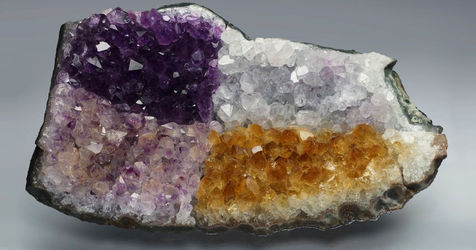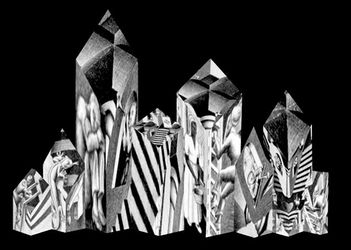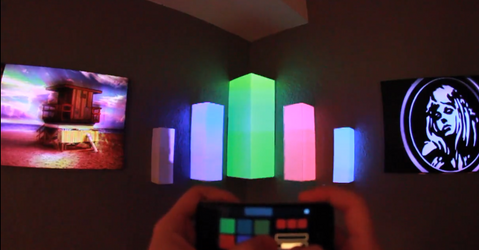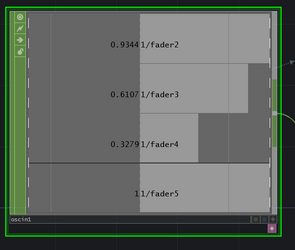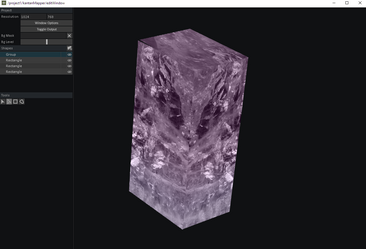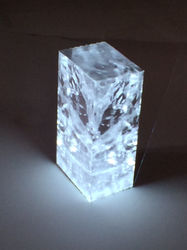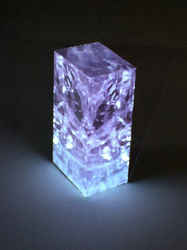
Project IMPURITY
An Interactive Projection Mapped Quartz Model
by Amanda Grace
The purpose of Project IMPURITY is to engage individuals in the process of color changes in the mineral, Quartz, caused by multiple environmental impurities that
an individual may change to affect the color and identification of the crystals.

WHY?
Project Impurity is fueled by my personal love for rocks, gemstones and minerals paired with a strong interest in sculpting and 3D modeling. Quartz is a popular mineral and comes in a wide variety of beautiful crystal specimens. However, I have found that many individuals do not know that minerals like amethyst and citrine are actually quartz. The differences are the colors caused by environmental impurities within the earth as quartz is formed. I chose projection mapping to project a quartz texture onto a 3D modeled quartz formation and combined it with an app that can increase and decrease the impurity levels which would cause the color changes. This interactivity will allow an individual to learn what causes quartz to change into amethyst and citrine to keep it simple.
WHAT?
Project Impurity is an attempt to understand how the mineral, quartz, undergoes change
in color by manipulating impurities present inside the mineral. The results change the identification of the mineral even though its base is quartz.
Minerals that come from quartz are many, but this project focuses on the change from crystal quartz to varieties of amethyst (violet), varieties of citrine (yellow to red) and even in between the two color extremes, ametrine (mix).
The impurities that can be increased and decreased are: iron, radiation, temperature and UV.
Iron is responsible for adding violet hues and changing crystal quartz to amethyst.
Radiation is responsible for intensifying color (saturation).
Temperature is responsible for changing amethyst hues to citrine hues.
UV is responsible for fading a color (tinting).
Projection mapped, quartz texture, prototype box.
Crystal quartz (left) amethyst variant (right).
HOW?
How could an individual in real time manipulate quartz impurities to change its color? Emil Polyak recommended me an app software called TouchOSC to use as a "control center" for adjusting the impurity levels. TouchOSC is capable of syncing with TouchDesigner and linking to visual color changes made in Touch Designer. For example, say the iron control on the TouchOSC app is interacted with and the iron level increases. The iron level is communicated to TouchDesigner and the color (violet) assigned to that level then becomes visible projecting onto the quartz model.
In order to project a quartz texture onto a quartz 3D model (such as the double terminated form), a tool within Touch Designer called the Kantan Mapper had to be used. Inside this tool,
I was able to manipulate where the projector would project onto a tall white box prototype.
A shape would be "shaped" to fit the faces of the box and then the quartz texture would be inserted within the shapes to create crystal quartz.
INSPIRATION
PROCESS
PROTOTYPE
CONCLUSION/ VISION
Project Impurity is looking to be a successful project, but there are more steps that have to be taken to bring it to a close finish. Through my process and testing, I discovered that linking the color changes in TouchDesigner to TouchOSC interactive impurity bars is a lot harder than I expected. The full shot of the pathways shown in the process gallery is actually just the process for one of the impurity bars, iron. At the moment the color change is not synced with TouchOSC and the iron bar. My next steps will be to properly sync the two and then repeat the pathways for the other three impurities so that the colors will change on the projected object in real time.
I also have an ambitious vision for this project. In the beginning my goal was to 3D print a double terminated quartz form in a semi transparent filament. This would be the final model hung from a blank wall where the projector would shine onto it from the ceiling. There would be a small table set to the side with a tablet. An individual would be prompted by text projected onto the wall to pick up the tablet and open the TouchOSC app where the individual could then begin to play with the impurities and see the color changes appear in real time onto the 3D quartz model.
My hope is to make all of this happen by the end of this studio and semester. If not, then a thorough and formal project pitch will do just fine.


